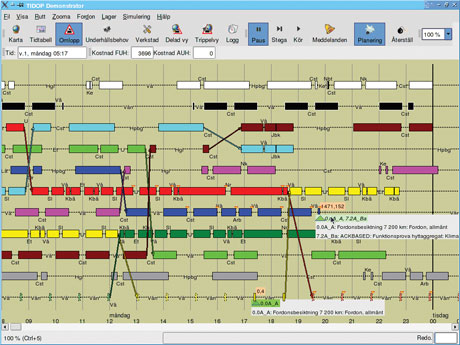by Anders Holst and Markus Bohlin
With the introduction of condition-based and predictive maintenance, today's fixed vehicle cycles designed for fixed maintenance intervals are no longer appropriate. We have shown that it is possible to construct vehicle circuits dynamically in response to condition monitoring and condition counters.
In rail transport, preventive maintenance is typically planned using fixed intervals in units of distance travelled and calendar time. For practical reasons, maintenance is grouped into packages with the same interval. An advantage of fixed interval maintenance is that plans for maintenance can be made in advance with relative precision at the same time as vehicle movements are planned. This is possible because in theory, the vehicle movement plan gives the exact consumption in calendar time and distance travelled for a vehicle at any point in the future.

The vehicle movement plan is typically based on fixed vehicle cycles. The cycles are laid out in such a way that each vehicle should be able to pass a workshop at least as often as the most frequent service package requires. Whenever an unplanned service demand occurs, the operator tries to let the vehicle switch routes with another vehicle in order to get it into the workshop as quickly as possible. After maintenance of the faulty vehicle, the two vehicles will typically switch back with each other again, so as not to disturb the vehicle cycles too much.
However, with the introduction of condition-based and predictive maintenance, the use of predetermined service packages and fixed service intervals is no longer appropriate. The drawbacks of such traditional maintenance are that it is inflexible, sub-optimal and – since maintenance is often done unnecessarily and parts are prematurely changed – wastes money. At the same time, other parts may wear out and break before the planned maintenance stop.
To minimize maintenance costs while avoiding expensive breakdowns, trains should be maintained at the best possible moment, considering factors such as vehicle condition, maintenance staff, workshop load, availability of spare parts, co-allocation benefits, downtime costs etc. Because many of these factors constantly change, short-notice planning and optimisation are necessary. Also, since the condition of the vehicles varies considerably with time, the component condition would have to be monitored continuously so that predictions regarding the future status of the vehicle are always available. With this information, it is possible to recreate with sufficient notice maintenance plans that fit with prediction and at the same time minimize costs.
To illustrate the potential of this concept, prototype software for integrating railroad vehicle diagnosis and operative vehicle circuit planning has been developed at SICS. This prototype combines the advantage of exact knowledge of individual train component conditions with planning algorithms, ensuring that vehicles arrive at the maintenance workshop at the best possible moment. The system simulates and evaluates train movements and wear and tear on components, and dynamically adjusts the vehicle circuits to automatically route vehicles in need of maintenance to the nearest workshop. In addition, spontaneous faults and failures are introduced during the simulation, the appearance of which also triggers re-planning and maintenance stops. The system has proven to be very robust in terms of meeting maintenance deadlines, which naturally is a critical property of a maintenance system.

In short, to take maximum advantage of knowing the exact condition of a technical system, eg a railway vehicle, this information must be connected directly to the company's operative planning strategy. We have shown that such a connection between condition monitoring and operations planning can indeed be established, with very beneficial results.
Link:
http://www.sics.se/iam/index.php?section=timm
Please contact:
Anders Holst and Markus Bohlin
SICS, Sweden
Tel: +46 8 633 1500
E-mail: anders.holst![]() sics.se, markus.bohlin
sics.se, markus.bohlin![]() sics.se
sics.se










